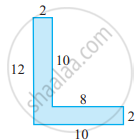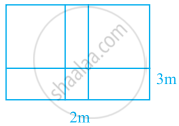Advertisements
Advertisements
प्रश्न
Here is a rectangle of an area of 20 square cm.

Draw one straight line in this rectangle to divide it into two equal rectangles. What is the area of each of the smaller rectangles?
उत्तर

A line can be drawn as shown in this figure to divide the given rectangle into two equal rectangles.
Similarly, a horizontal line can also be drawn to divide the given rectangle into two equal rectangles.
Area of each smaller rectangle
= `1/2` × Area of the bigger rectangle
= `1/2 xx 20`
= 10 square cm
APPEARS IN
संबंधित प्रश्न
A rectangular hall is 12 m long and 6 m broad. Its flooring is to be made of square tiles of side 30 cm. How many tiles will fit in the entire hall? How many would be required if tiles of side 15 cm were used?
Find the area of a rectangle whose length and breadth are 12 cm and 4 cm respectively.
The side of a square is 4 cm. The length of a rectangle is 8 cm and its width is 2 cm. Find the perimeter and area of both figures.
The length of a rectangular park is 14 m more than its breadth. If the perimeter of the park is 200 m, what is its length? Find the area of the park
Find the area of the following rectangle
length = 6 cm and breadth = 3 cm
Find the area of the following rectangle
length = 8 cm and breadth = 5 cm
What will be the labour cost of laying the floor of an assembly hall which is 14 m long and 10 m breadth if the cost of laying is ₹ 60 per sq.m?
Find the area of the rectangle whose sides are:
3 cm and 4 cm
Split the following shape into rectangle and find their area. (The measures are given in centimetres).

A school playground is divided by a 2 m wide path which is parallel to the width of the playground, and a 3 m wide path which is parallel to the length of the ground in the given figure. If the length and width of the playground are 120 m and 80 m respectively, find the area of the remaining playground.

